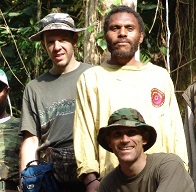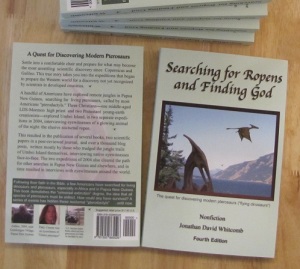Ten years ago David Woetzel and Garth Guessman climbed mountains and interviewed natives on Umboi Island (AKA Siasi) in Papua New Guinea. I pray that their expedition will not be forgotten, for how dramatic were their discoveries, notwithstanding the ropen of Umboi appearing unwilling to cooperate except through one or two brief glowing episodes. I have no doubt that the flying creature seen by native eyewitnesses is a Rhamphorhynchoid pterosaur. I submit a few quotations from the fourth edition of my nonfiction Searching for Ropens and Finding God.
From page 93
Guessman and Woetzel left California October 17, arriving in the city of Lae on October 19, Papua New Guinea time, where they met missionary Jim Blume and his wife, Mary. Here, Guessman interviewed both Jim Blume and Pastor Jacob Kepas. Blume had founded fifty-two Baptist Churches in Papua New Guinea, and under his leadership Kepas had founded nine.
Both Blume and Kepas would reveal what they had seen but there’s more: Blume had previously spoken with about seventy eyewitnesses of what we call ropens, and Kepas would soon become deeply involved by going with the two Americans to Umboi Island as their interpreter . . .
From page 94
Rather than take a ship, as I had, those three flew to Umboi Island in a small plane, searching the landscape as they passed over the center of the island. Because the pilot had no interest in zigzagging, they flew directly to the northern coast which they followed to the air strip at Lab Lab.
Here the three ropen investigators met Peter Ake, magistrate of Mararamu Village, and the four men took a banana boat along the northeast coast. Kepas interprets between English and Tok Pisin, but Peter also interprets between English and the local dialect of Kovai.
From page 95
Stopping to refuel at Kampalap, they learned that villagers occasionally see the ropen as it leaves a cave, most recently three weeks earlier. The local man said, “Taim em kam aut . . . save . . . taim em go bek, em no gat.” They know when it leaves the cave but not when it returns. The creature flies to a promontory north of the village, landing and waiting on a tree top before flying out to the reef.
Interpreting the man’s Tok Pisin, Peter explained the belief that the ropen waits to see if it is being watched before it flies to the reef to feed. What it eats, the man was unsure. He was also unsure of the size, admitting that it’s only a light that they see, but his hand gestures showed his belief: The ropen is bigger than a man.
About a week later, Woetzel had his own sighting of the flying ropen light. After the expedition, Woetzel answered my questions about the encounter.
From page 98
“My sighting was so quick that it was impossible to get a video—maybe two seconds. The light was very different from what Garth and Pastor Jacob saw. I suspect theirs was a meteor. I also saw some meteors while on night watch. They were whitish in color and had a tail.
“But this thing was different. It went about as fast as a meteor, but it was very different in coloration . . . almost golden and shimmering around the edges. . . . There was no tail and it was flying horizontally from Mt. Barik toward Mt. Tolo.”
###
.
Rhamphorhynchoid in South Carolina
“It looked as big as any car, and had NO feathers, not like a huge crane or egret. . . . it swooped down over the highway and back up gracefully over the pines.”
Before you dismiss the concept of a modern pterosaur (in particular, of a long-tailed featherless Rhamphorhynchoid), consider the many eyewitness testimonies of those flying creatures.
.
Nicknamed “the Bible of modern pterosaurs,” this nonfiction ropen book is a large-paperback of 360 pages
.




